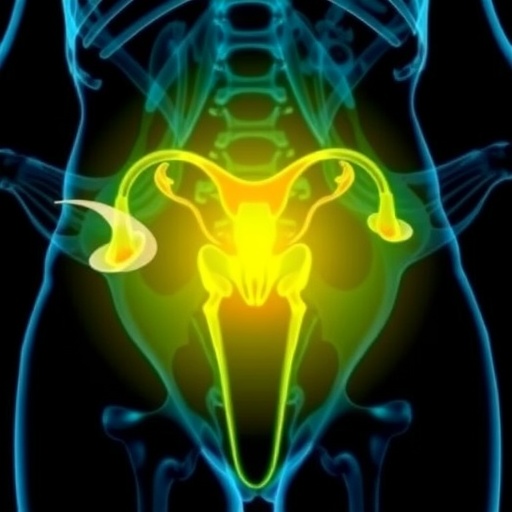In an inspiring leap forward for ovarian cancer therapy, recent preclinical research demonstrates that a novel radioimmunotherapy utilizing Terbium-161 (^161Tb) holds remarkable promise in eradicating ovarian cancer stem cells (CSCs), a critical driver of tumor relapse and resistance to conventional treatments. This pioneering study offers a beacon of hope in the battle to definitively target and eliminate CSCs, cells notorious for their robust regenerative properties and their role in therapy evasion. Released in the July 2025 issue of The Journal of Nuclear Medicine, these findings shed light on a sophisticated, precision-driven approach that may redefine the modalities of cancer care.
Cancer stem cells, especially those expressing specific biomarkers such as L1CAM and CD133, pose significant challenges owing to their capacity for self-renewal and tumorigenesis. They are implicated not only in initial tumor development but also in metastatic spread and recurrence following therapy. Traditional treatment strategies often fail to effectively target these resilient subpopulations, leading to complex clinical difficulties. The advent of radioimmunotherapy introduces a new avenue by conjugating radioactive isotopes to antibodies that selectively bind these CSC-associated antigens, delivering lethal doses of radiation directly to malignant cells with minimized collateral damage to healthy tissue.
The groundbreaking aspect of this recent study revolves around the radionuclide ^161Tb, an innovatively harnessed isotope emitting short-range conversion and Auger electrons alongside beta particles. These emissions confer an intensified cytotoxic payload compared to the widely used Lutetium-177 (^177Lu), amplifying DNA damage within CSCs upon molecular binding. This enhanced particle profile enables more efficient irradiation of target cells, capitalizing on the spatial precision inherent to radioimmunotherapy, thus maximizing tumor cell kill while sparing normal cells.
.adsslot_xSKmaczGrD{width:728px !important;height:90px !important;}
@media(max-width:1199px){ .adsslot_xSKmaczGrD{width:468px !important;height:60px !important;}
}
@media(max-width:767px){ .adsslot_xSKmaczGrD{width:320px !important;height:50px !important;}
}
ADVERTISEMENT
Researchers first confirmed the presence of L1CAM+/CD133+ ovarian cancer stem cells within patient-derived tumor samples, establishing a vital clinical foundation for targeted intervention. The subsequent preparation of radioimmunoconjugates, where the chimeric antibody chCE7 was labeled with either ^161Tb or ^177Lu, allowed for comparative cytotoxic assessments. These assays, conducted both in vitro through cell proliferation tests and in vivo using ovarian cancer xenograft mouse models, revealed the superior potency of the ^161Tb-DOTA-chCE7 conjugate in obliterating ovarian CSC populations.
Data derived from these investigations unequivocally showed that ^161Tb-based radioimmunotherapy eradicated all detected ovarian CSCs and their differentiated progeny in live animal models. Notably, this complete elimination effectively prevented tumor growth, a milestone outcome rarely achieved in preclinical oncology models. The pronounced efficacy of ^161Tb contrasts with the relatively limited results observed with ^177Lu conjugates, underscoring the critical role of emission profile optimization for therapeutic success.
Dr. Jürgen Grünberg of the Paul Scherrer Institute elucidated the mechanistic rationale underpinning these results, highlighting that ^161Tb’s emission of short-ranged electrons results in highly localized energy deposition. This radiobiological advantage facilitates the infliction of irreparable double-stranded DNA breaks within CSCs, overcoming their notorious radioresistance. Consequently, ^161Tb radioimmunotherapy represents a powerful candidate for tackling therapy-refractory CSCs, potentially circumventing the predominant hurdles that have stalled CSC-targeted treatments.
Complementing these insights, Dr. Tihomir Todorov emphasized the translational potential of this work, advocating for further development of ^161Tb-based therapeutics as tailored interventions within the personalized medicine framework. With the integration of molecular imaging and theranostic capabilities, such radionuclide therapies could simultaneously offer diagnostic clarity and therapeutic precision. This dual utility holds promise not only for managing ovarian cancer but also for expanding the treatment landscape for other malignancies driven by resistant CSC populations.
Furthermore, the investigation highlighted the pivotal role of tubular and sheathing structures within ovarian tumors that facilitate CSC protection and survival. By utilizing the potent emission characteristics of ^161Tb, the radioimmunotherapy effectively penetrates these microenvironments, demonstrating capacity to disrupt even the most sheltered cancer reservoirs. This capability may be transformative in preventing tumor recurrence, a significant clinical obstacle in current ovarian cancer management.
The study also incorporated rigorous control experiments to rule out systemic toxicity and ensure selective targeting. Histological analysis and monitoring of organ function in treated animals confirmed favorable safety profiles for ^161Tb radioimmunotherapy, a critical requirement for clinical translation. These findings bolster confidence in advancing toward human trials, where safety and efficacy must align to bring new therapeutic options to patients.
In the broader context of oncology, the success of ^161Tb-based radioimmunotherapy underscores the evolving paradigm of harnessing radioisotope physics for precision medicine. The emission properties of radionuclides can be strategically leveraged to not only destroy primary tumor cells but also target elusive cellular subsets like CSCs, which evade standard chemotherapeutic and radiotherapeutic tactics. As research continues, optimizing antibody selection, radionuclide pairing, and dosing strategies will be vital for harnessing the full potential of this approach.
In conclusion, the superior efficacy of ^161Tb-DOTA-chCE7 radioimmunotherapy fortifies the concept that radionuclide physics tailored to cellular microenvironments can decisively impact cancer treatment paradigms. With the challenge of CSC eradication previously a critical barrier, this research opens avenues not only for ovarian cancer but also scaled adaptations in other solid tumors. The scientific and clinical communities eagerly await subsequent clinical trials that may usher an era of precision radioimmunotherapy, transforming cancer from a recalcitrant adversary into a manageable condition.
Subject of Research: Ovarian cancer stem cells and targeted radioimmunotherapy with Terbium-161
Article Title: 161Tb-Based Anti-L1CAM Radioimmunotherapy Shows Superior Efficacy in Eliminating Ovarian Cancer Stem Cells Compared with 177Lu in Preclinical Models of Ovarian Cancer
News Publication Date: July 24, 2025
Web References:
Journal of Nuclear Medicine Article
JNM Website
SNMMI Website
Image Credits: Images created by Jürgen Grünberg, PhD, and Tihomir Todorov, PhD, Center of Radiopharmaceutical Sciences, Paul Scherrer Institute
Keywords: Ovarian cancer, cancer stem cells, radioimmunotherapy, Terbium-161, Lutetium-177, L1CAM, CD133, targeted radionuclide therapy, personalized medicine, molecular imaging, cancer treatments
Tags: advancements in cancer stem cell researcheliminating therapy-resistant cancer cellsinnovative approaches to cancer careL1CAM and CD133 biomarkers in cancerminimizing collateral damage in cancer treatmentnovel radioimmunotherapy for ovarian cancerovercoming tumor relapse in ovarian cancerprecision medicine in oncologypreclinical research in oncologyradioactive isotopes in targeted therapytargeting cancer stem cells in ovarian cancerTerbium-161 in cancer treatment





